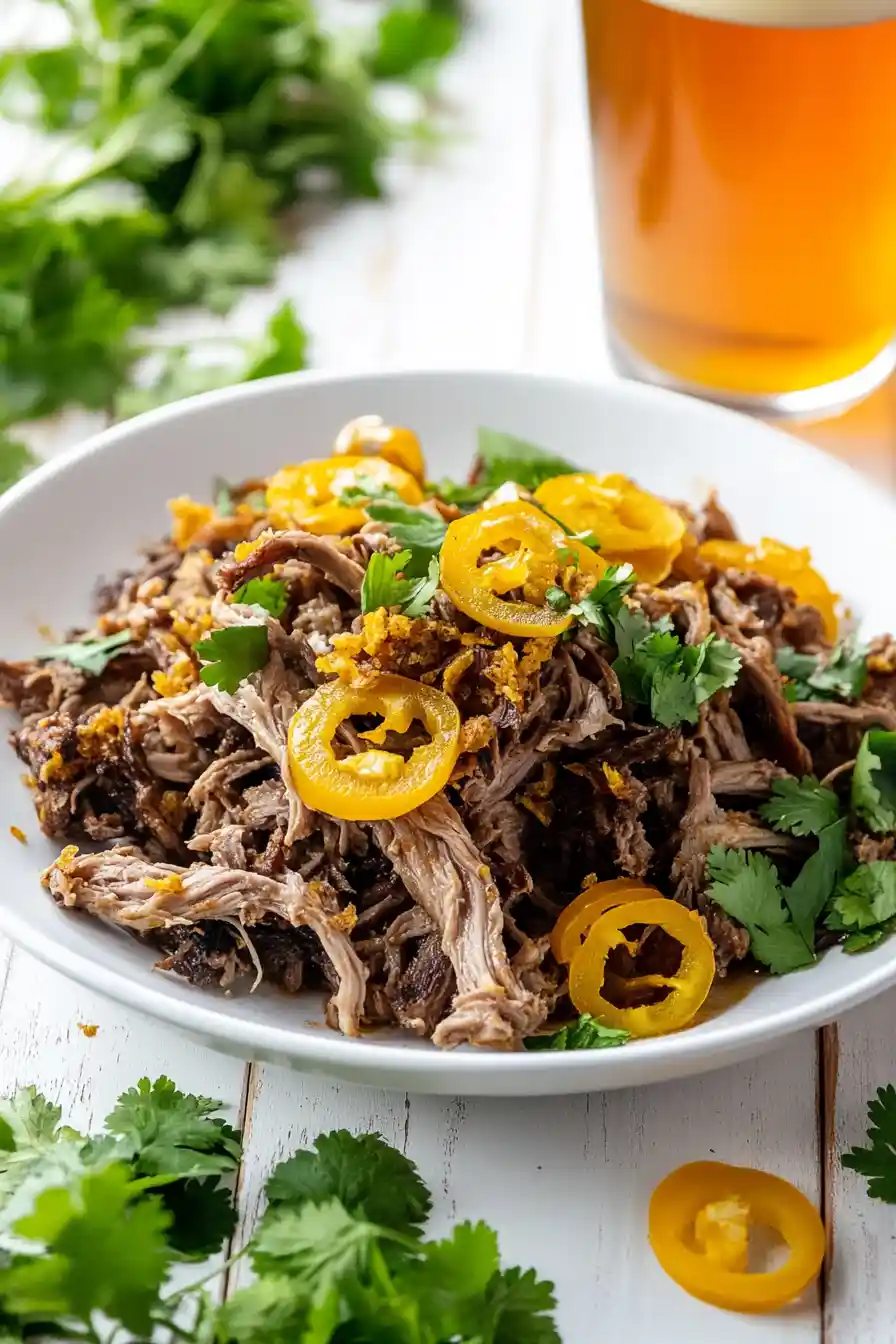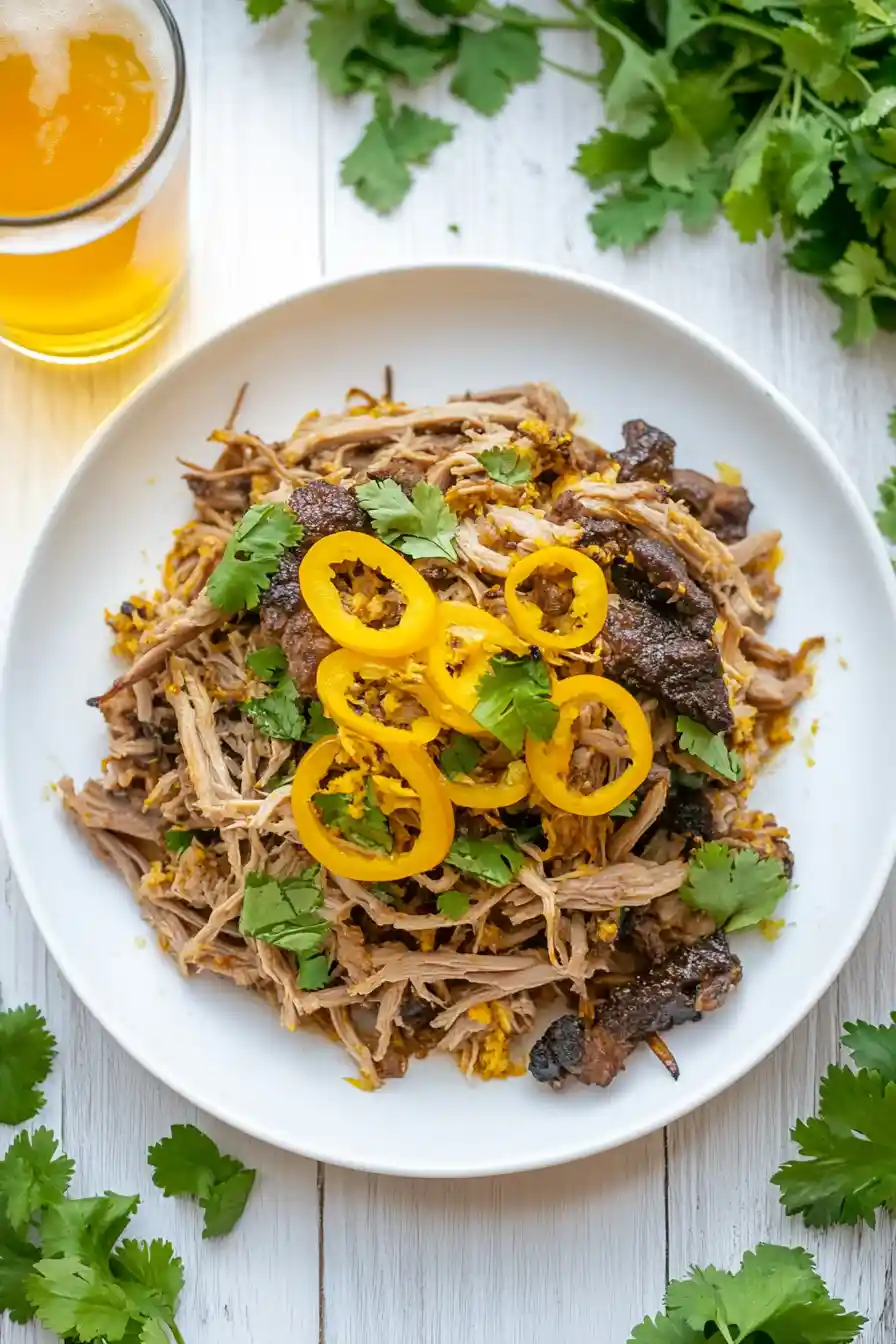If you ask me, Jamaican jerk pork shoulder is one of those recipes that just makes any day better.
This Caribbean classic brings the right balance of heat and spice, with a marinade that works its magic into every bite of tender meat. The slow-cooked pork comes out juicy on the inside with a nicely charred exterior that’ll have everyone coming back for seconds.
The combination of scotch bonnet peppers, allspice, and fresh thyme creates that authentic jerk flavor that’s hard not to love. And while it takes some time to cook, most of it is hands-off – just let your oven do the work.
It’s the kind of laid-back weekend cooking that fills your house with good smells and promises an amazing dinner ahead.

Why You’ll Love This Jerk Pork
- Bold Caribbean flavors – The combination of scotch bonnets, warm spices, and rum creates that authentic Jamaican jerk taste you can’t get from store-bought marinades.
- Make-ahead friendly – You can marinate the pork overnight, making it perfect for planning ahead and ensuring the meat absorbs all those amazing flavors.
- Fall-apart tender meat – The long, slow cooking process breaks down the tough pork shoulder into incredibly tender, juicy meat that pulls apart easily with a fork.
- Great for gatherings – This recipe makes enough to feed a crowd, and the leftovers taste even better the next day as the flavors continue to develop.
- Simple ingredients – While the ingredient list might look long, most are common spices and pantry staples that create layers of flavor without any fancy ingredients.
What Kind of Pork Shoulder Should I Use?
For Jamaican jerk pork, you’ll want to look for either a pork shoulder (also called pork butt or Boston butt) that’s well-marbled with fat. The cut typically weighs between 4-8 pounds and has enough fat running through it to keep the meat moist during the long cooking process. If you’re shopping at the grocery store, you might find it either bone-in or boneless – both work great, though bone-in tends to add more flavor and helps keep the meat from drying out. For the best results, pick a piece that has a nice pink color and white fat marbling throughout, and avoid any meat that looks overly pale or has dark spots.

Options for Substitutions
While authentic Jamaican jerk seasoning has some key ingredients you shouldn’t skip, there’s still room for some practical swaps:
- Habanero/Scotch Bonnet Peppers: These peppers give authentic jerk flavor, but if needed, use 2-3 Thai chilies or 4-5 serrano peppers. The heat level will be different, but you’ll still get that spicy kick. Just remember – scotch bonnets have a unique fruity flavor that other peppers can’t fully match.
- Spiced Rum: No rum? Use apple juice or pineapple juice mixed with a splash of apple cider vinegar. The flavor won’t be exactly the same, but it’ll still add moisture and sweetness.
- Five-spice mix: If you don’t have five-spice, mix equal parts cinnamon, star anise (or fennel), and ground black pepper. It’s not perfect, but it works in a pinch.
- Fresh Ginger: You can use 1 teaspoon ground ginger if fresh isn’t available, though fresh really does work better here.
- Pork Shoulder/Butt: While pork shoulder is ideal, you could use pork loin – just know it won’t be as juicy and you’ll need to reduce cooking time to avoid drying it out.
- Allspice: This is a must-have for jerk seasoning – there’s really no good substitute that will give you authentic jerk flavor.
Watch Out for These Mistakes While Cooking
The biggest mistake when preparing Jamaican jerk pork is not giving the marinade enough time to work its magic – this dish needs at least 12 hours (preferably 24) in the marinade to develop those deep, complex flavors. When handling the scotch bonnet peppers, always wear gloves and avoid touching your face, as these peppers are extremely hot and can cause serious discomfort if they get on your skin or in your eyes. The third crucial error is cooking the pork at too high a temperature – low and slow is the way to go, maintaining a steady 250-275°F to break down the tough muscle fibers and create that melt-in-your-mouth texture you’re looking for. For the best results, use a meat thermometer and cook until the internal temperature reaches 195°F, then let it rest for at least 30 minutes before shredding or slicing to keep all those flavorful juices locked inside.

What to Serve With Jamaican Jerk Pork?
This spicy, flavorful jerk pork pairs perfectly with traditional Caribbean sides that help balance out the heat. Rice and peas (made with coconut milk) is a classic choice that soaks up all the tasty meat juices. For some cooling elements, try serving it with fresh mango salsa or creamy coleslaw – both help tame the spiciness from the scotch bonnets. I also love adding some grilled plantains or sweet potato wedges on the side, and don’t forget a piece of warm cornbread to round out the meal. If you want to keep things simple, some steamed vegetables like cabbage or carrots work great too.
Storage Instructions
Keep Fresh: Once your Jamaican jerk pork is cooked, let it cool down and place it in an airtight container in the fridge. It’ll stay good for up to 4 days, and honestly, the flavors get even better after a day or two as they continue to meld together!
Freeze: This jerk pork is perfect for freezing! Portion it out into freezer-safe containers or bags, making sure to include some of the cooking juices to keep the meat moist. It’ll keep well in the freezer for up to 3 months. I like to freeze it in meal-sized portions for easy weeknight dinners.
Warm Up: To enjoy your leftover jerk pork, let frozen portions thaw overnight in the fridge. Then gently warm it up in a covered pan over low heat with a splash of water or chicken broth to keep it juicy. You can also use the microwave – just heat it in short bursts and stir occasionally to ensure even warming.
| Preparation Time | 15-30 minutes |
| Cooking Time | 450-480 minutes |
| Total Time | 465-510 minutes |
| Level of Difficulty | Medium |
Estimated Nutrition
Estimated nutrition for the whole recipe (without optional ingredients):
- Calories: 1800-2000
- Protein: 100-120 g
- Fat: 120-140 g
- Carbohydrates: 50-60 g
Ingredients
For the marinade:
- 1 onion (roughly chopped)
- 1 tbsp black pepper (freshly ground preferred)
- 1 tsp salt
- 1 tbsp five-spice mix
- 6 green onions
- 1/4 cup spiced rum
- juice of 3 limes
- 1 tbsp allspice powder
- 1/4 tsp ground cloves
- 1/2 cup soy sauce (I like Kikkoman brand)
- 3 garlic cloves (freshly minced for best flavor)
- 1 inch ginger (peeled)
- 4 habanero or scotch bonnet peppers (stems removed)
- 2 tbsp dark brown sugar (packed well)
- 1 tsp ground cinnamon
- 1 tsp ground nutmeg
- 1 tbsp olive oil
For the pork:
- 1 pork shoulder or butt (about 5-6 lbs, bone-in for more flavor)
Step 1: Prepare the Marinade
Combine chopped peppers, onion, green onions, ginger, garlic, sugar, and spices in a food processor.
Blend until all ingredients are roughly combined.
With the machine running, slowly add soy sauce, rum, lime juice, and olive oil to create a smooth marinade.
Be prepared for an intense peppery aroma when you remove the lid; this is perfectly normal.
Step 2: Marinate the Pork
Reserve ½-1 cup of the marinade based on the size of your pork.
Pierce 1-inch slits throughout the top and bottom of the pork butt.
Pour the marinade over the pork and turn it several times to coat it evenly.
Use your fingers to work some marinade into the slits.
Cover and refrigerate the pork for at least overnight, or up to 24 hours for maximum flavor absorption.
Step 3: Pre-Cooking Preparation
If possible, remove the pork butt from the refrigerator one hour before cooking to bring it to room temperature.
Prepare your preferred cooking method from the options below: oven roasting or slow cooking.
Step 4: Oven Roasting Method
- Preheat the oven to 275 degrees F.
Remove any excess marinade from the pork.
- Line a roasting pan with foil and place a well-coated roasting rack inside.
- Use a wide-mouth meat injector to inject the reserved marinade evenly throughout the pork.
- Insert a leave-in meat thermometer into the thickest part of the pork, avoiding contact with bones.
- Roast uncovered until the internal temperature reaches 155-165 degrees F.
- Remove the pork, wrap it in food-grade butcher paper or heavy-duty foil, reinsert the thermometer, and return to the oven.
- Continue cooking until the internal temperature is between 190 and 200-205 degrees F.
Step 5: Slow Cooker Method
- Remove any excess marinade from the pork.
- Inject the reserved marinade throughout the pork using a wide-mouth meat injector.
- Place the pork in a slow cooker with 1 cup of water or chicken stock.
- Cook on low for eight hours until the pork becomes fall-apart tender.
Step 6: Resting and Serving
Once cooked, allow the meat to rest, wrapped, for at least 15 minutes or up to 30-45 minutes to let the juices redistribute throughout.
For the slow cooker method, keep it on warm during this rest period.
Shred the rested pork using two forks and serve hot.
Enjoy your deliciously tender pork!

